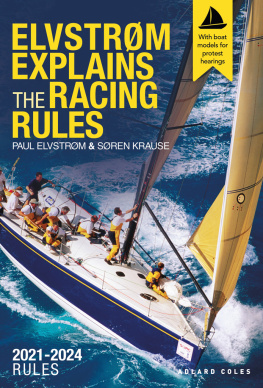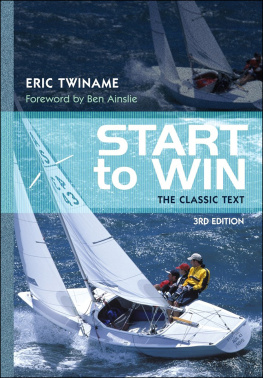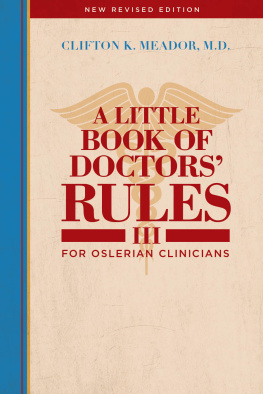
Dedication
To my mother and father who taught me the first rule I knew
CONTENTS
Eric Twiname was an active dinghy sailor, a keen team racer and a Laser National Champion. He liked to look at the rules from the competitors point of view. He campaigned successfully to get the turns penalty system into the rulebook (before its introduction, boats had to retire whenever they broke a rule) and hed have been delighted to see that the Two-Turns Penalty is now the standard penalty system in the main body of the rules. He also tried, unsuccessfully, to get the order of the rules changed to put the sections of most interest to the competitor at the front of the book. Twenty years later the rules were reorganised almost exactly as he proposed.
Eric wrote regular rules articles in the 1970s which were so popular that he used the same comic-strip style for his famous Rules Book, which he wrote after serving for several years on the Royal Yachting Associations Racing Rules Committee.
It was Eric who persuaded me to join the RYA Racing Rules Committee under the chairmanship of Gerald Sambrooke-Sturgess who, with Greg Bemis from the United States, first developed a set of international racing rules. Eric would be very pleased to see the dramatically simplified rules that came into effect in 1997.
Erics tragic death in 1980 meant a great loss both to his friends and to racing sailors everywhere. His Rules Book has helped countless helmsmen to grasp the principles of the racing rules, and in making the changes necessary for the book to comply with the current rules, I have been careful not to change Erics unique method of presentation, which is so popular all over the world.
I am very grateful to Marianne Middelthon from Norway, a long-standing member of the ISAF Racing Rules Committee, for her collaboration in updating the book to take account of the new rules.
Bryan Willis
Erics name and memory live on not only in this book. The Eric Twiname Memorial Trust, a registered charity, helps youngsters start and progress in the sport of sailing. Its address is:

Dinny Reed, Administrator
Eric Twiname Memorial Trust
Sycamore Cottage
Shortheath Common, Kingsley
Borden, Hants GU35 9JS
Every year at the Conference of the International Sailing Federation, improvements and amendments are made to the racing rules, but only every four years (in the year following the Olympic Games) are the new rules published. This tenth edition of The Rules Book has been revised to include the changes that came into force on 1 January 2013. Most of the changes are for clarification, but some change the way the game is played.
If you are new to racing and this is your first book on the rules, you really dont need to read this section because comparing what the rules were to what they are now will be of little interest. Move on to the real-life situations, or put the book with your kit ready to refer to it if there is an incident you are unsure about. This section is for sailors who have been racing for a while.
As usual, there are many small changes aimed at making rules easier to understand or less ambiguous.
But there are also a few changes that affect the way the game of sailing is played. Ill start with the important changes and then go on to the ones of interest only to the rules gurus:
 The definition Finish: A boat used to finish simply by crossing the finishing line in the direction of the course from the last mark. This was a problem when it was unclear which was the last mark, or the course included several laps and the finishing line was positioned in the middle of the course so that boats went through the finishing line on each lap. The direction is now defined as crosses the finishing line from the course side. But the definition continues by making it clear that if a boat is taking a Turn Penalty after crossing the finishing line, she actually did not finish when she crossed the line the first time; after taking the penalty she must cross the line from the course side again. The crossing of the finishing line also does not count as finishing if the boat thereafter corrects an error in sailing the course that she made at the finishing line. Last but not least, a boat doesnt finish if she continues to sail the course. In all these cases, the boat does not actually finish until she has completed the penalty, corrected the error or completed sailing the course and then finishes.
The definition Finish: A boat used to finish simply by crossing the finishing line in the direction of the course from the last mark. This was a problem when it was unclear which was the last mark, or the course included several laps and the finishing line was positioned in the middle of the course so that boats went through the finishing line on each lap. The direction is now defined as crosses the finishing line from the course side. But the definition continues by making it clear that if a boat is taking a Turn Penalty after crossing the finishing line, she actually did not finish when she crossed the line the first time; after taking the penalty she must cross the line from the course side again. The crossing of the finishing line also does not count as finishing if the boat thereafter corrects an error in sailing the course that she made at the finishing line. Last but not least, a boat doesnt finish if she continues to sail the course. In all these cases, the boat does not actually finish until she has completed the penalty, corrected the error or completed sailing the course and then finishes.
 The definition Keep Clear has been changed so that the test of whether the leeward boat can change course in both directions without immediately making contact with the windward boat now also applies to the starboard-tack boat when running downwind alongside a port-tack boat.
The definition Keep Clear has been changed so that the test of whether the leeward boat can change course in both directions without immediately making contact with the windward boat now also applies to the starboard-tack boat when running downwind alongside a port-tack boat.
 A fender attached to the port quarter of the committee boat at the starboard end of a starting line to protect the paintwork was arguably temporarily attached to the mark and therefore not a part of it, allowing boats to collide with it with impunity. The words temporarily attached have been replaced with attached accidentally in the definition Mark, so that the fender now counts as part of the mark.
A fender attached to the port quarter of the committee boat at the starboard end of a starting line to protect the paintwork was arguably temporarily attached to the mark and therefore not a part of it, allowing boats to collide with it with impunity. The words temporarily attached have been replaced with attached accidentally in the definition Mark, so that the fender now counts as part of the mark.
 The definition Mark-Room has been changed to correct some anomalies. The old definition included room to sail to the mark and then room to sail her proper course while at the mark. This meant that the amount of room the inside boat was entitled to suddenly changed when she was at the mark. The new definition actually reduces the amount of room the inside boat is entitled to at the mark; basically she has the right to room to sail in a seamanlike way to the mark and round the mark.
The definition Mark-Room has been changed to correct some anomalies. The old definition included room to sail to the mark and then room to sail her proper course while at the mark. This meant that the amount of room the inside boat was entitled to suddenly changed when she was at the mark. The new definition actually reduces the amount of room the inside boat is entitled to at the mark; basically she has the right to room to sail in a seamanlike way to the mark and round the mark.
 The definition Room has been changed to make it clearer that when, for example, you luff more than one boat, you must give room for the windward boat to fulfil his obligations to give room to any boat(s) windward of him.
The definition Room has been changed to make it clearer that when, for example, you luff more than one boat, you must give room for the windward boat to fulfil his obligations to give room to any boat(s) windward of him.
 There is a new Basic Principle named Environmental Responsibility: Participants are encouraged to minimise any adverse environmental impact of the sport of sailing. This really isnt a rule at all since a boat or competitor cannot break it.
There is a new Basic Principle named Environmental Responsibility: Participants are encouraged to minimise any adverse environmental impact of the sport of sailing. This really isnt a rule at all since a boat or competitor cannot break it.
 In addition to the Basic Principle there is a new rule 55 Trash Disposal. If you deliberately put any kind of trash (waste material, refuse) in the water you can be penalised for breaking this rule. However, you will not be penalised, for example, for capsizing and not being able to retrieve objects that might be categorised as trash. There is a reminder to all sailors in the preamble to Part 4 that this requirement applies at all times when boats are on the water (preamble to Part 4 and rule 55).
In addition to the Basic Principle there is a new rule 55 Trash Disposal. If you deliberately put any kind of trash (waste material, refuse) in the water you can be penalised for breaking this rule. However, you will not be penalised, for example, for capsizing and not being able to retrieve objects that might be categorised as trash. There is a reminder to all sailors in the preamble to Part 4 that this requirement applies at all times when boats are on the water (preamble to Part 4 and rule 55).
 Rule 14 used to be rather odd in that a right-of-way boat was required to avoid contact with another boat if reasonably possible but could not be penalised unless the contact caused damage or injury. It raised the question as to whether a right-of-way boat could intentionally break rule 14 and rely on not being penalised. The words have been changed to shall be exonerated if she breaks this rule, a phrase previously used, for example, in rule 18 (Mark-Room). (Rule 14).
Rule 14 used to be rather odd in that a right-of-way boat was required to avoid contact with another boat if reasonably possible but could not be penalised unless the contact caused damage or injury. It raised the question as to whether a right-of-way boat could intentionally break rule 14 and rely on not being penalised. The words have been changed to shall be exonerated if she breaks this rule, a phrase previously used, for example, in rule 18 (Mark-Room). (Rule 14).
Next page









 The definition Finish: A boat used to finish simply by crossing the finishing line in the direction of the course from the last mark. This was a problem when it was unclear which was the last mark, or the course included several laps and the finishing line was positioned in the middle of the course so that boats went through the finishing line on each lap. The direction is now defined as crosses the finishing line from the course side. But the definition continues by making it clear that if a boat is taking a Turn Penalty after crossing the finishing line, she actually did not finish when she crossed the line the first time; after taking the penalty she must cross the line from the course side again. The crossing of the finishing line also does not count as finishing if the boat thereafter corrects an error in sailing the course that she made at the finishing line. Last but not least, a boat doesnt finish if she continues to sail the course. In all these cases, the boat does not actually finish until she has completed the penalty, corrected the error or completed sailing the course and then finishes.
The definition Finish: A boat used to finish simply by crossing the finishing line in the direction of the course from the last mark. This was a problem when it was unclear which was the last mark, or the course included several laps and the finishing line was positioned in the middle of the course so that boats went through the finishing line on each lap. The direction is now defined as crosses the finishing line from the course side. But the definition continues by making it clear that if a boat is taking a Turn Penalty after crossing the finishing line, she actually did not finish when she crossed the line the first time; after taking the penalty she must cross the line from the course side again. The crossing of the finishing line also does not count as finishing if the boat thereafter corrects an error in sailing the course that she made at the finishing line. Last but not least, a boat doesnt finish if she continues to sail the course. In all these cases, the boat does not actually finish until she has completed the penalty, corrected the error or completed sailing the course and then finishes.